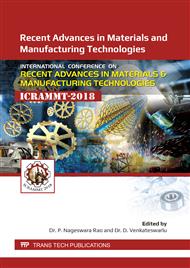p.595
p.601
p.607
p.613
p.619
p.625
p.631
p.637
p.644
Effect of Microstructure and Mechanical Properties of Austenitic Stainless Steel 1.6mm Butt Welded by Plasma Arc Welding
Abstract:
Plasma Arc Welding (PAW) is more tolerant to joint misalignment than Laser Beam Welding (LBW) at a lower cost [1]. The present study deals with the assessment of mechanical and metallurgical properties of butt welded 1.6 mm thick austenitic stainless steel similar (SS304 and SS304) by using plasma arc welding technique. Similar butt-Welded joints were analyzed by using mechanical (Bend test, Erichsen cup test, tensile test) and metallurgical (Optical macroscopic and microscopic images) characterization methods. The bead width and depth of the butt welded 1.6mm thick butt joined SS304 was analyzed by macroscopic and microscopic images [2]. The Erichsen cup test was conducted on the weld specimens. The indentation was made on the weld specimens. In the similar metal joint the depth of indentation is high, which shows that the similar metal joint has better formability. This makes them appropriate for practicing in the aircraft industries (engine parts), automotive sector (engine-parts and assemblies) chemical processing, food processing, turbine buckets, pumps and valve parts [3]. Keywords: SS304, PAW, Butt weld, Erichsen Cup Test, Microstructure
Info:
Periodical:
Pages:
619-624
Citation:
Online since:
August 2019
Keywords:
Price:
Сopyright:
© 2019 Trans Tech Publications Ltd. All Rights Reserved
Share:
Citation:


